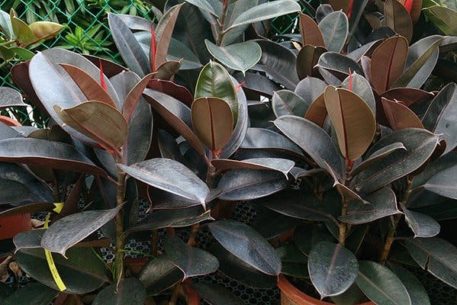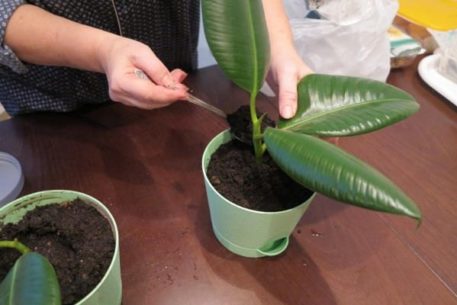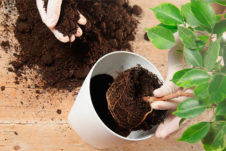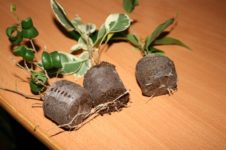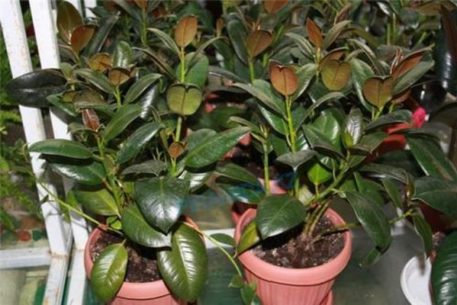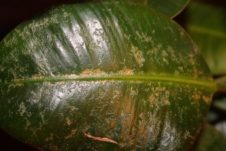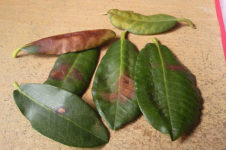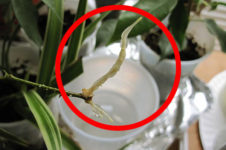Ficus, a rubber tree with impressive dimensions, has long adorned the windowsills of apartments and houses with its glossy leaves. However, not all lovers of the mulberry representative have enough space to create comfortable living conditions for him. Thanks to the continuous work of breeders, a more compact variety of the main species, Ficus Melanie, was recently introduced.
Material Content:
Grade description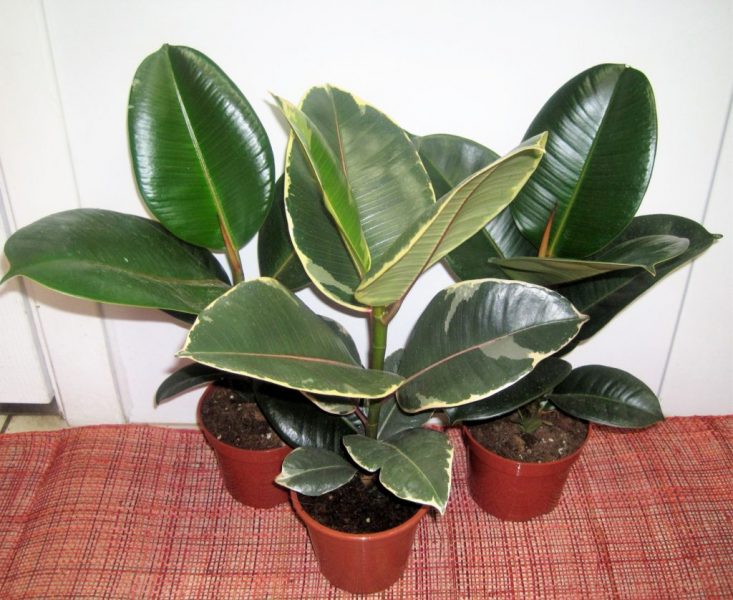
Ficus elastica Melanie is the most compact variety of a typical type, which is perfect for growing in small rooms. Thanks to the densely arranged leathery leaves with a glossy finish and a length of up to 15 cm, the flower has a lush crown, which is particularly decorative. At home, the plant does not bloom.
Important! A feature of the variety is growth in the form of a branchy bush.
Optimal conditions for growing
To create optimal conditions for the maintenance of ficus in the room, it is necessary to take into account the characteristics of the flower and its requirements.
Soil requirements
To form a thick and beautiful crown that will decorate the interior, ficus needs a fertile, loose soil mixture. A substrate with suitable characteristics is sold in specialized stores. You can prepare it yourself by combining leaf, turf soil, sand and peat in equal parts.
Lighting
Ficus Melanie loves a large amount of scattered light, which he will be able to provide windows east or west.Since ficus is a plant of long daylight hours, it is recommended to organize additional illumination with the help of fluorescent lamps in winter.
Temperature
Comfortable temperature in the spring and summer is 22-30 ° C. With the onset of winter cold, if possible, lower the temperature in the room to 16-18 ° C. The critical temperature minimum below which the root system of the ficus can be affected is 12 ° C.
Humidity
The representative of the tropical flora likes to be in a room with a high level of humidity. To reduce the air dryness of the apartment, you should regularly spray ficus with standing water at room temperature.
Ficus Melanie Home Care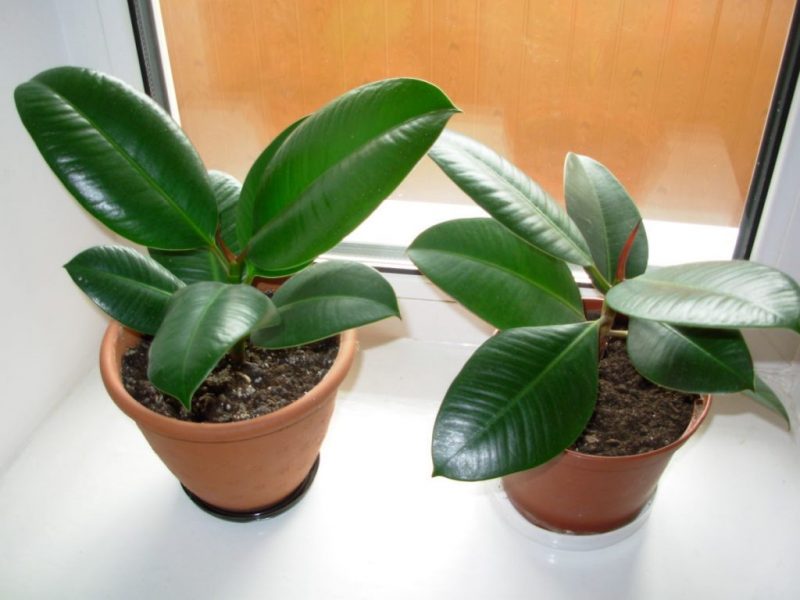
During the period of growth and development, caring for a varietal representative of a rubber-bearing ficus is quite simple.
Watering and hygiene procedures
Watering a drought-resistant ficus should be moderate, after the earthen coma dries to a depth of 2-4 cm. For adult specimens, the drying depth can increase to 12 cm. After watering, excess water in the pan necessarily merges so as not to provoke the development of gray rot. In order to maintain the cleanliness and beauty of the sheet plates, it is recommended to periodically wipe them with a damp sponge.
Fertilizing and fertilizers
Ficus Melanie, which has monophonic green leaves, is fed three times a month during the active vegetation period with the help of liquid mineral fertilizers with a high nitrogen content, which stimulates the development of a lush crown.
Cropping and shaping the crown
In early spring, the ficus Melanie must be cut off, which will help to give the crown the desired shape and prevent the stretching of the shoots. To stop growing up and stimulate branching, it is necessary to shorten the flower 4-6 sheets down.
Plant transplant after purchase
After the acquisition, Ficus Melanie is transplanted into a new container with fresh substrate only after 30 days of quarantine, during which it will be isolated from other indoor plants.
If a young specimen was purchased, then, in the subsequent transplant, every spring is carried out. An adult ficus is suitable for an interval of 3-4 years.
Regardless of the reasons, the transplant is carried out as follows:
1. Select a pot with a diameter of 2-3 cm larger than the previous one.
2. Good drainage is placed at the bottom.
3. Ficus with an earthen lump is being reloaded into a new container.
4. The remaining space is filled with prepared nutrient substrate.
5. The soil is compacted and moistened.
Pest and Disease Control
Ficus Melanie, like rubber ficus, is attacked by scabies, thrips and spider mites when the air is too dry. To prevent the appearance of pests, you should sometimes organize a warm shower for the plant and wipe the leaves with a damp sponge. If settlement has already occurred, then it is necessary to immediately treat the flower with an insecticide. Among the diseases on the ficus, manifestations of gray rot caused by stagnation of moisture or bays can be noted. As protective measures, normalize the irrigation regime and spray the plant with a fungicide solution in accordance with the manufacturer's instructions indicated on the package.
Plant propagation
For the propagation of ficus Melanie, vegetative methods are used - with the help of a handle or an air layer.
Cuttings
In late spring and early summer, the procedure is as follows:
1. Cuttings are prepared with a length of 15 cm and an oblique cut.
2. The sheet above the cut is cut by ⅓.
3. Milky juice, characteristic of ficuses, is washed off with water.
4. Cuttings are dried for 2-3 hours, and then the places of the slices are processed by the root-forming agent.
5. The disinfected container is filled with a mixture of peat and sand, in which cuttings are placed until the second internode.
6. The container is covered with polyethylene to create the necessary indicators of humidity and temperature.
7.When the cuttings take root, as evidenced by newly formed leaves, the plants are planted in separate pots.
Air layering
A more time-consuming method in which:
1. The bare part of the shoot is cut in a circle.
2. The damaged area is covered with moss, which is fixed with adhesive tape or other handy material.
3. In the process of root formation, moss is kept moist.
4. When aerial roots are formed at the lay, the shoot is separated from the mother plant and placed in an individual tank filled with a fertile soil mixture.
What problems can a flower grower face?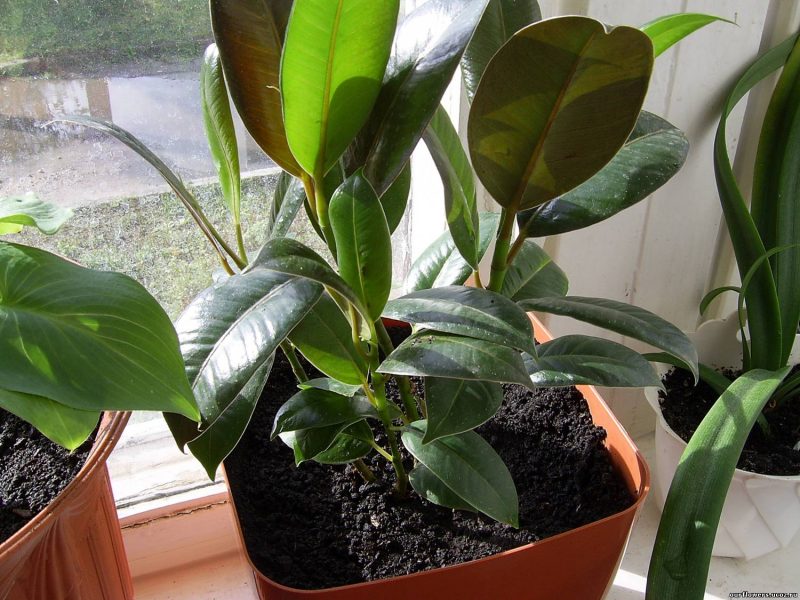
Despite the undemanding nature of a compact plant from the tropics, its cultivation in a room environment can be complicated by the emergence of a number of problems:
• Leaves turn yellow and fall off - difficulty can arise due to overflows, as well as due to the colonization of shoots by sucking pests that feed on leaf juice.
• The stem darkens - due to stagnation of moisture and the development of root rot, in which it is necessary to remove the affected roots and transplant the flower into a fresh substrate, the shoot may darken.
• Foliage takes on a brown hue - the situation is noted with a lack of nutrients in the substrate, which is subject to regular enrichment and renewal.
• The tips of the leaves dry - the reason lies in the excessively dry air, which can be moistened by spraying or installing a stationary humidifier.
• Red spots appear - if spots on the shoots with a diameter of 1-3 cm appear on the shoots, it is necessary to move the flower to another place where direct sunlight does not fall, burning ficus.
Thus, ficus lovers will appreciate the compact Melanie variety, captivating with its beauty and ease of maintenance.


